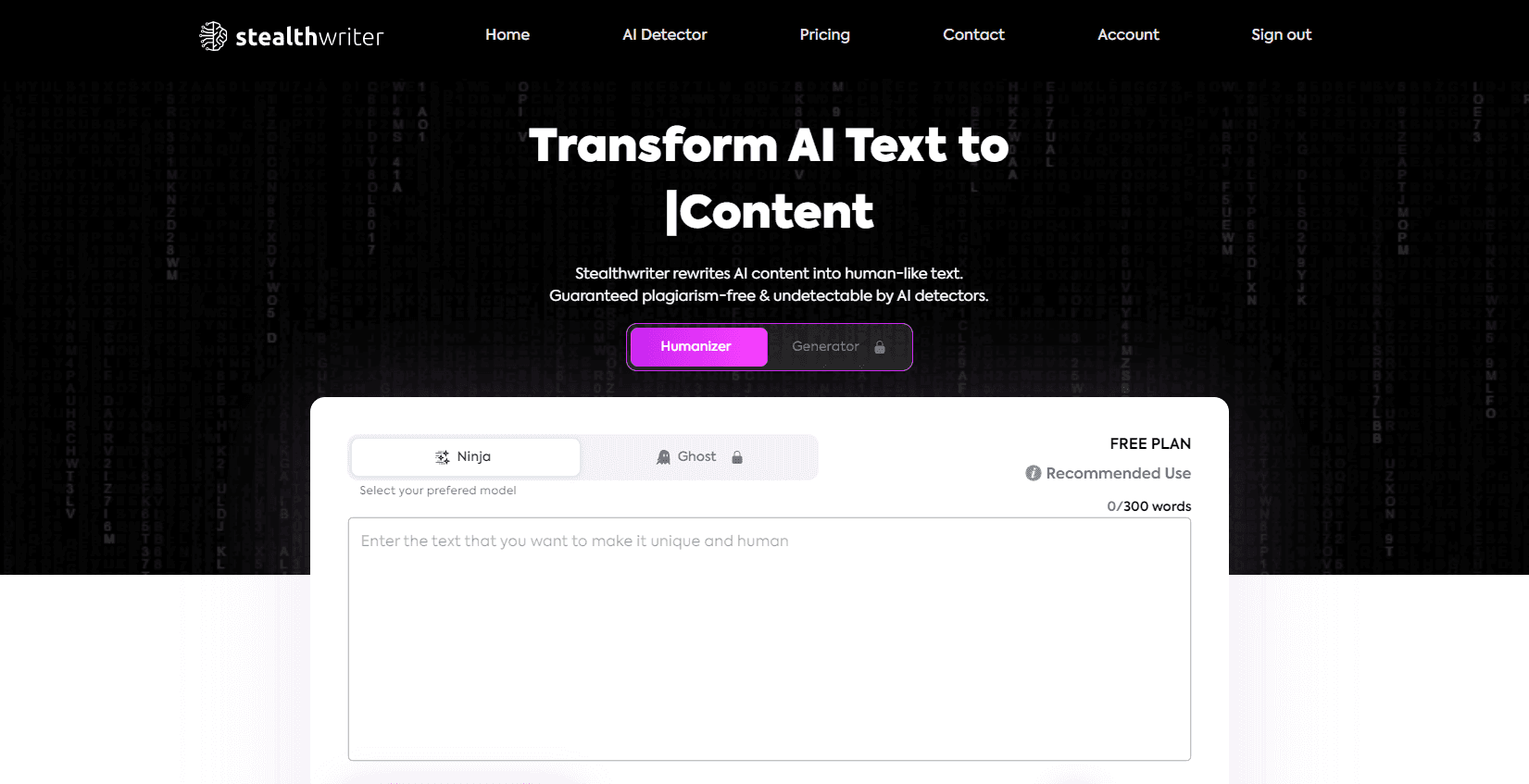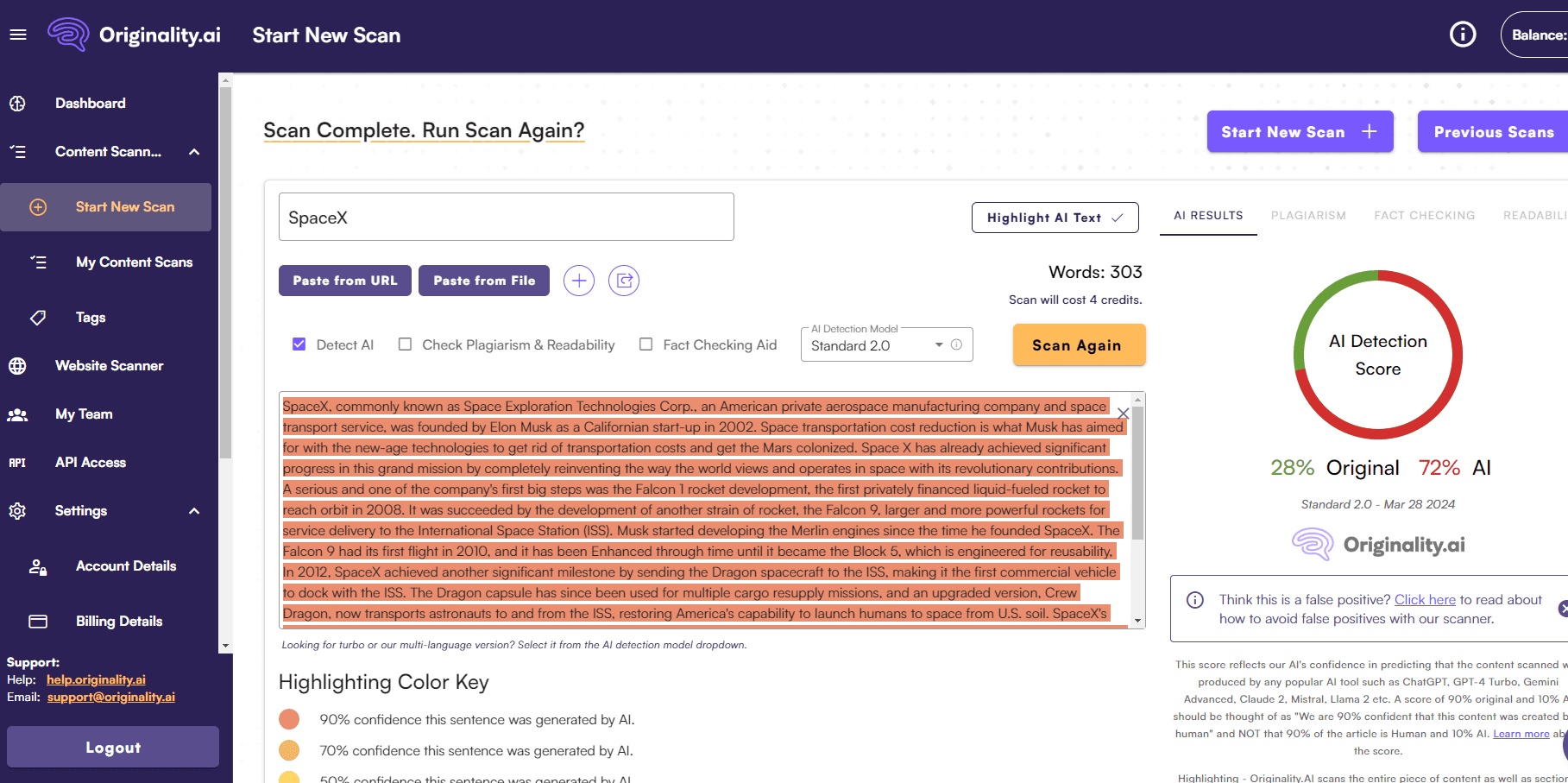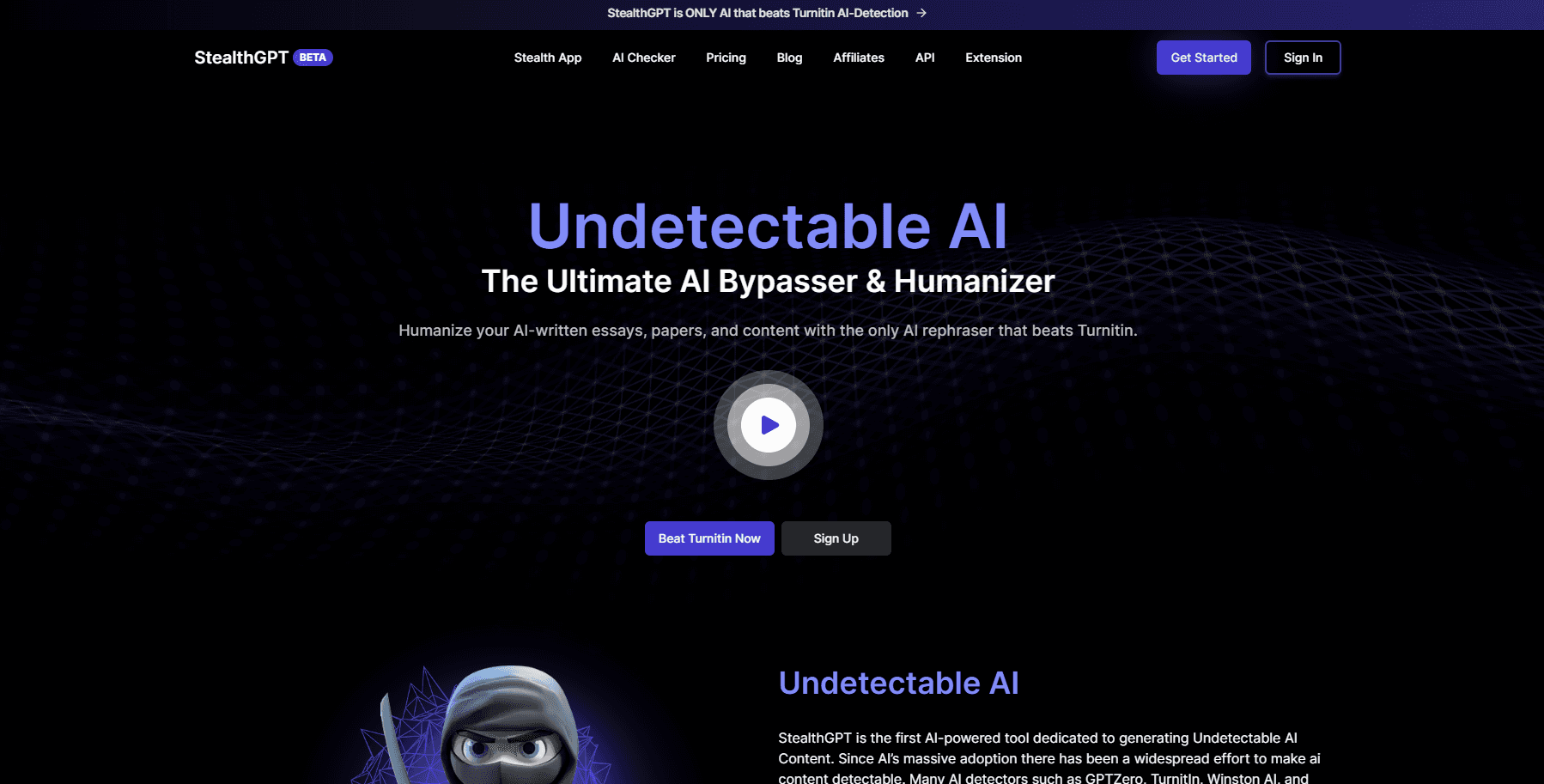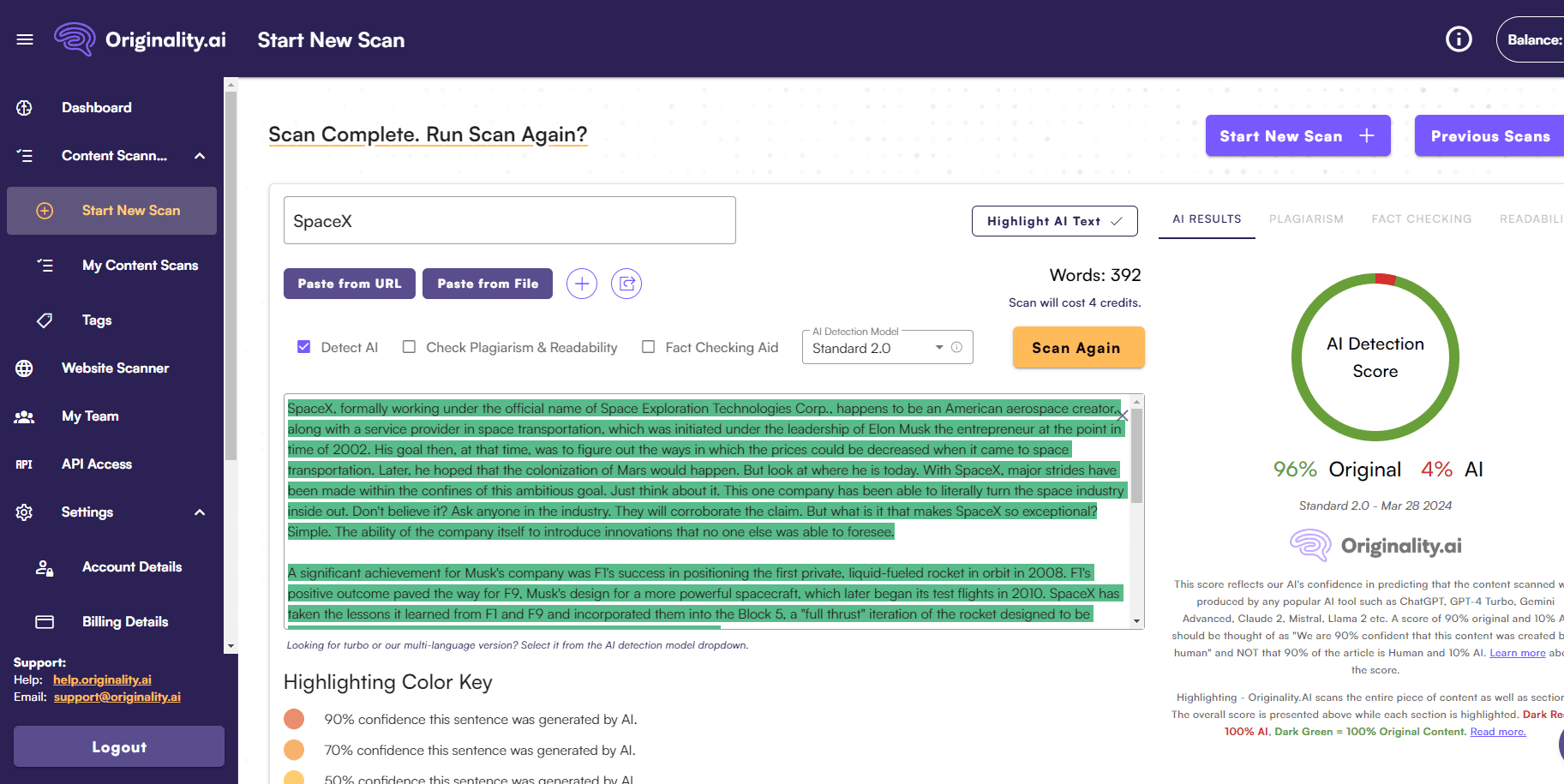AI Detection
Can StealthWriter Bypass OrginalityAI?
In this study, we explored the intricacies of StealthWriter, emphasizing its unique attributes and design which distinguish it in the field of artificial intelligence. Our examination focused on the foundational technology of StealthWriter, including its algorithms, user interface, and key performance metrics. Central to our investigation was StealthWriter's goal to mimic human writing styles precisely, striving to produce content that appears to be penned by a human. This feature is crucial for various uses, from creating content to evading detection mechanisms designed to spot AI-generated texts, thereby raising significant ethical and technical issues.Additionally, a vital part of our research centered on assessing the efficacy of StealthWriter, especially its claims of outperforming detection models like Originality AI. Originality AI has been noted for its superior ability to differentiate between human and AI-written texts, setting a standard for the non-detectability of AI-generated content. We carried out comparative analyses and tests to pit StealthWriter’s outputs against the detection capabilities of Originality AI. Through assessing detection rates, margins of error, and specific cases where StealthWriter either slipped through undetected or was caught by Originality AI, we gained insights into its limitations and possible improvements for making AI-generated content more indistinguishable.Our examination also included testing StealthWriter's capacity to elude Originality AI, with a particular emphasis on its assertions of successfully avoiding the tool’s detection mechanisms. Contrary to these assertions, our results indicated that StealthWriter consistently did not evade detection by this AI detector, highlighting a gap between its claimed and actual effectiveness. We intend to dive deeper into these test outcomes, analyzing the reasons behind their shortcomings. Based on these results, we will introduce an alternate solution, StealthGPT, which seems to promise better efficacy in circumventing detection tools like Originality AI, potentially offering a more efficient option for producing AI-written content that cannot be distinguished. The advent of Artificial Intelligence (AI) has revolutionized the fields of content creation and academic writing, introducing innovative tools that enhance productivity while emphasizing the importance of ethical use. These AI-driven tools help users organize their content more effectively, provide recommendations to improve language and flow and increase engagement, thereby elevating the quality of written work. AI also plays a pivotal role in detecting plagiarism, and upholding the principles of originality and integrity within and beyond academic environments. Through AI’s ability to compare documents against a broad spectrum of sources, users can ensure their work is unique, respecting intellectual property and promoting a culture of ethical responsibility and transparency in both content creation and academic research.The introduction of AI bypass tools represents a crucial step in navigating the fine line between leveraging AI for content generation and maintaining ethical and authentic standards in academic, professional, and creative fields. These tools are designed to modify AI-generated content in such a way that it goes undetected by AI identification systems, which are increasingly implemented by educational institutions, publishers, and online platforms to filter out non-original or AI-assisted submissions. The primary aim of these bypass tools is to assist creators in incorporating AI into their workflow while maintaining the semblance of human input, thus ensuring the broader acceptance of AI-assisted content in settings where direct AI contributions are restricted or frowned upon.With the proliferation of AI-generated content on various platforms, the importance of AI bypass tools has grown, providing creators with vital resources to harness AI’s capacity for boosting creativity and efficiency while avoiding sophisticated AI detection techniques. In educational contexts, these tools help students leverage AI for preliminary research and drafting, guaranteeing that their final submissions maintain a personal voice and meet academic integrity standards. In professional and creative writing, AI bypass tools facilitate the use of AI in the initial stages of drafting, with further edits incorporating personal insights and originality. This approach highlights the ethical application of AI in content creation, positioning it as a supportive tool rather than a replacement for human creativity and intelligence. This strategy promotes innovation while preserving the core values of originality and authenticity in content production.
The advent of Artificial Intelligence (AI) has revolutionized the fields of content creation and academic writing, introducing innovative tools that enhance productivity while emphasizing the importance of ethical use. These AI-driven tools help users organize their content more effectively, provide recommendations to improve language and flow and increase engagement, thereby elevating the quality of written work. AI also plays a pivotal role in detecting plagiarism, and upholding the principles of originality and integrity within and beyond academic environments. Through AI’s ability to compare documents against a broad spectrum of sources, users can ensure their work is unique, respecting intellectual property and promoting a culture of ethical responsibility and transparency in both content creation and academic research.The introduction of AI bypass tools represents a crucial step in navigating the fine line between leveraging AI for content generation and maintaining ethical and authentic standards in academic, professional, and creative fields. These tools are designed to modify AI-generated content in such a way that it goes undetected by AI identification systems, which are increasingly implemented by educational institutions, publishers, and online platforms to filter out non-original or AI-assisted submissions. The primary aim of these bypass tools is to assist creators in incorporating AI into their workflow while maintaining the semblance of human input, thus ensuring the broader acceptance of AI-assisted content in settings where direct AI contributions are restricted or frowned upon.With the proliferation of AI-generated content on various platforms, the importance of AI bypass tools has grown, providing creators with vital resources to harness AI’s capacity for boosting creativity and efficiency while avoiding sophisticated AI detection techniques. In educational contexts, these tools help students leverage AI for preliminary research and drafting, guaranteeing that their final submissions maintain a personal voice and meet academic integrity standards. In professional and creative writing, AI bypass tools facilitate the use of AI in the initial stages of drafting, with further edits incorporating personal insights and originality. This approach highlights the ethical application of AI in content creation, positioning it as a supportive tool rather than a replacement for human creativity and intelligence. This strategy promotes innovation while preserving the core values of originality and authenticity in content production. StealthWriter is a cutting-edge artificial intelligence application tailored for generating written content that emulates human writing with remarkable accuracy. Its defining feature is the production of text, such as articles and essays, that defy easy identification as AI-generated, blending seamlessly with human-authored works. At the heart of StealthWriter's breakthrough is its advanced deployment of AI algorithms that fine-tune syntax, style, and vocabulary, thus enabling its output to evade detection by AI monitoring systems. This feature is crucial in areas where the genuineness of human creation is vital, providing a smooth avenue for employing AI in the content creation workflow without setting off alarms from AI surveillance mechanisms.Employing the Generative Pre-trained Transformer (GPT) architecture at its core, StealthWriter excels in grasping contextual nuances, replicating a wide range of writing styles, and circumventing the typical hallmarks that AI content detectors look for. Its aim is not merely to produce text that can be mistaken for human-written but to ensure the resulting content is of superior quality and logical consistency, presenting a significant challenge to conventional detection approaches, such as linguistic scrutiny and pattern detection. Ongoing enhancements and a commitment to ethical usage are central to its success, helping StealthWriter to consistently outpace the advancing capabilities of detection technologies. As such, StealthWriter emerges not only as an instrument for content generation but also as an innovative approach to preserving the authenticity and invisibility of AI-supported content creation efforts.
StealthWriter is a cutting-edge artificial intelligence application tailored for generating written content that emulates human writing with remarkable accuracy. Its defining feature is the production of text, such as articles and essays, that defy easy identification as AI-generated, blending seamlessly with human-authored works. At the heart of StealthWriter's breakthrough is its advanced deployment of AI algorithms that fine-tune syntax, style, and vocabulary, thus enabling its output to evade detection by AI monitoring systems. This feature is crucial in areas where the genuineness of human creation is vital, providing a smooth avenue for employing AI in the content creation workflow without setting off alarms from AI surveillance mechanisms.Employing the Generative Pre-trained Transformer (GPT) architecture at its core, StealthWriter excels in grasping contextual nuances, replicating a wide range of writing styles, and circumventing the typical hallmarks that AI content detectors look for. Its aim is not merely to produce text that can be mistaken for human-written but to ensure the resulting content is of superior quality and logical consistency, presenting a significant challenge to conventional detection approaches, such as linguistic scrutiny and pattern detection. Ongoing enhancements and a commitment to ethical usage are central to its success, helping StealthWriter to consistently outpace the advancing capabilities of detection technologies. As such, StealthWriter emerges not only as an instrument for content generation but also as an innovative approach to preserving the authenticity and invisibility of AI-supported content creation efforts. Below is the content after undergoing the StealthWriter process. Next, we'll examine how Originality AI evaluates this refined content.
Below is the content after undergoing the StealthWriter process. Next, we'll examine how Originality AI evaluates this refined content.
 In a recent test conducted to assess the capabilities of StealthWriter, an AI writing tool advertised to create content undetectable by AI detectors, the results were unexpectedly revealing. The content produced by StealthWriter was subjected to analysis by Originality AI, a platform known for its efficiency in identifying AI-generated text. The outcome was a disappointing 72% AI score, a clear indication that the content was predominantly recognized as being generated by artificial intelligence. This score not only challenges StealthWriter's claims of producing stealthy, undetectable AI content but also raises questions about the reliability and effectiveness of its algorithms in creating genuinely human-like text.The implications of this test are significant for users relying on StealthWriter for creating content that is supposed to bypass AI detection mechanisms. With the burgeoning use of AI detectors in various sectors, from academic institutions to content creation industries, the need for AI writing tools to produce original, indistinguishable content has never been more critical. However, StealthWriter's apparent inability to fulfill this requirement undermines its utility and market positioning. This result prompts a reevaluation of the strategies employed by AI writing tools in mimicking human writing styles and the technological advancements necessary to truly achieve undetectability.
In a recent test conducted to assess the capabilities of StealthWriter, an AI writing tool advertised to create content undetectable by AI detectors, the results were unexpectedly revealing. The content produced by StealthWriter was subjected to analysis by Originality AI, a platform known for its efficiency in identifying AI-generated text. The outcome was a disappointing 72% AI score, a clear indication that the content was predominantly recognized as being generated by artificial intelligence. This score not only challenges StealthWriter's claims of producing stealthy, undetectable AI content but also raises questions about the reliability and effectiveness of its algorithms in creating genuinely human-like text.The implications of this test are significant for users relying on StealthWriter for creating content that is supposed to bypass AI detection mechanisms. With the burgeoning use of AI detectors in various sectors, from academic institutions to content creation industries, the need for AI writing tools to produce original, indistinguishable content has never been more critical. However, StealthWriter's apparent inability to fulfill this requirement undermines its utility and market positioning. This result prompts a reevaluation of the strategies employed by AI writing tools in mimicking human writing styles and the technological advancements necessary to truly achieve undetectability. StealthGPT is rising as a pivotal tool in the domain of AI-generated content, introducing creative ways to bypass AI detection systems. This tool is tailored to alter AI-produced content to make it appear as though it was written by a human. It accomplishes this through modifications in text elements such as syntax, style, and choice of words, helping it to slip past AI content detectors unnoticed. This innovation holds significant value in settings where the perception of genuine human authorship is paramount, offering a seamless means of leveraging AI in content creation without triggering alerts from AI detection mechanisms.Utilizing the Generative Pre-trained Transformer framework, StealthGPT specializes in creating content that resembles human writing, through an understanding of context, the emulation of diverse styles, and the avoidance of patterns typically targeted by AI detectors. This poses a substantial challenge to conventional AI detection strategies, like linguistic analysis and pattern identification, in recognizing StealthGPT-generated materials. With ongoing enhancements and ethical usage in mind, StealthGPT stays at the forefront of evading detection technologies, establishing itself as an effective instrument for crafting digital content that mirrors human input.This segment dives into the compelling attributes of StealthGPT, spotlighting its superior features compared to StealthWriter and its capacity to effectively navigate past Originality AI. We investigate the advanced algorithms and strategies StealthGPT employs to blend into existing frameworks seamlessly, granting users superior functionality while dodging detection technologies. By contrasting its features with StealthWriter's, we elucidate the reasons StealthGPT emerges as the go-to solution for individuals aiming to preserve the secrecy of their AI-assisted content. Additionally, we examine its success in eluding Originality AI's surveillance, illustrating its relevance in situations where unmasking AI-generated text poses a risk. Through this examination and comparison, our goal is to offer an in-depth insight into StealthGPT's role in the continuously advancing field of AI technology.
StealthGPT is rising as a pivotal tool in the domain of AI-generated content, introducing creative ways to bypass AI detection systems. This tool is tailored to alter AI-produced content to make it appear as though it was written by a human. It accomplishes this through modifications in text elements such as syntax, style, and choice of words, helping it to slip past AI content detectors unnoticed. This innovation holds significant value in settings where the perception of genuine human authorship is paramount, offering a seamless means of leveraging AI in content creation without triggering alerts from AI detection mechanisms.Utilizing the Generative Pre-trained Transformer framework, StealthGPT specializes in creating content that resembles human writing, through an understanding of context, the emulation of diverse styles, and the avoidance of patterns typically targeted by AI detectors. This poses a substantial challenge to conventional AI detection strategies, like linguistic analysis and pattern identification, in recognizing StealthGPT-generated materials. With ongoing enhancements and ethical usage in mind, StealthGPT stays at the forefront of evading detection technologies, establishing itself as an effective instrument for crafting digital content that mirrors human input.This segment dives into the compelling attributes of StealthGPT, spotlighting its superior features compared to StealthWriter and its capacity to effectively navigate past Originality AI. We investigate the advanced algorithms and strategies StealthGPT employs to blend into existing frameworks seamlessly, granting users superior functionality while dodging detection technologies. By contrasting its features with StealthWriter's, we elucidate the reasons StealthGPT emerges as the go-to solution for individuals aiming to preserve the secrecy of their AI-assisted content. Additionally, we examine its success in eluding Originality AI's surveillance, illustrating its relevance in situations where unmasking AI-generated text poses a risk. Through this examination and comparison, our goal is to offer an in-depth insight into StealthGPT's role in the continuously advancing field of AI technology. The content generated by ChatGPT has been processed using StealthGPT’s bypass functionality for this purpose.
The content generated by ChatGPT has been processed using StealthGPT’s bypass functionality for this purpose. In a revealing examination of StealthGPT's capabilities, we submitted its output to Originality AI for analysis, yielding a surprisingly low AI detection score of only 4%. This outcome starkly contrasts with expectations for AI-generated content detection, suggesting that StealthGPT possesses an advanced ability to mimic human-like writing closely. The low AI score indicates a significant breakthrough in the development of AI writing technologies, positioning StealthGPT as a powerful tool in the creation of content that defies current AI detection methodologies. This result not only underscores the sophistication of StealthGPT's algorithm but also highlights the evolving challenge of distinguishing between human and AI-generated content in an increasingly digital landscape.
In a revealing examination of StealthGPT's capabilities, we submitted its output to Originality AI for analysis, yielding a surprisingly low AI detection score of only 4%. This outcome starkly contrasts with expectations for AI-generated content detection, suggesting that StealthGPT possesses an advanced ability to mimic human-like writing closely. The low AI score indicates a significant breakthrough in the development of AI writing technologies, positioning StealthGPT as a powerful tool in the creation of content that defies current AI detection methodologies. This result not only underscores the sophistication of StealthGPT's algorithm but also highlights the evolving challenge of distinguishing between human and AI-generated content in an increasingly digital landscape.
Table of Contents
- Background
- Looking Deeper into StealthWriter
- Understanding StealthWriter
- Features of StealthWriter
- Testing StealthWriter’s Capabilities
- StealthWriter vs Originality AI Results
- StealthGPT As a Worthy Opponent
- Features of StealthGPT
- Putting StealthGPT to The Same Test
- Conclusion

Looking Deeper into StealthWriter

Understanding StealthWriter
StealthWriter utilizes advanced artificial intelligence based on the Generative Pre-trained Transformer (GPT) framework, laying the foundation for its unparalleled skill in crafting content that closely resembles human writing. This sophisticated AI framework equips StealthWriter with the ability to parse the context it operates within, mimic a variety of writing styles, and choose words with precision, all while steering clear of easily detectable patterns that could signal AI involvement. Through the application of machine learning and natural language processing (NLP), StealthWriter subtly alters syntax and semantics, producing output that is not only of superior quality but also distinct enough to pass unnoticed by AI detection tools. This refined method of generating content enables StealthWriter to produce texts ranging from scholarly articles to imaginative fiction, indiscernible from those penned by humans.Its proficiency in eluding AI detectors stems from its dynamic learning capabilities and constant updates. StealthWriter continually assimilates new information and examples of writing, equipping it to navigate the shifting landscapes recognized by AI detection tools such as Originality AI. It adeptly captures the essence of human writing, emulating the depth and individual quirks that are typically absent in more direct AI-generated texts. Moreover, StealthWriter integrates feedback mechanisms and ethical standards into its development, ensuring the technology's application is conscientious and supportive of human creative expression. These processes of continuous improvement and ethical consideration are key to StealthWriter's success in generating content that not only superficially appears human-authored but also holds up under the rigorous analysis of advanced AI detection strategies, making it an indispensable asset for creators aiming to harness the benefits of AI while preserving the integrity of their work.Features of StealthWriter
Adaptable Writing Styles: StealthWriter is adept at emulating a variety of writing styles, making it suitable for a broad range of content needs from academic essays to creative narratives and professional documents.Contextual Comprehension: Leveraging state-of-the-art natural language processing (NLP) methods, it accurately interprets the context of its generated text, ensuring relevance and appropriateness in its output.Syntax and Vocabulary Refinement: The tool fine-tunes syntax and selects vocabulary that mirrors the nuances of human writing, boosting the text's appeal and coherence, while also circumventing AI detection mechanisms.Progressive Learning Mechanism: StealthWriter continually enriches its database with fresh examples of writing and stylistic elements, empowering it to adapt and stay ahead of emerging AI detection tools through ongoing learning.Plagiarism Mitigation: It employs advanced algorithms to verify the originality of its output, minimizing plagiarism concerns by cross-referencing the generated text with an extensive database of existing materials.Personalization Features: StealthWriter provides customizable settings for tone, style, and complexity level, enabling users to generate content that precisely aligns with their specific requirements and preferences.Testing StealthWriter’s Capabilities
Originality AI emerges as a sophisticated tool crafted to pinpoint AI-generated content, responding to the increasing challenge of differentiating between texts produced by humans and machines in today’s digital realm. It employs cutting-edge machine learning and natural language processing (NLP) technologies to scrutinize writings for traits, patterns, and styles indicative of AI authorship. This scrutiny encompasses analysis of textual coherence, sentence construction, and the occurrence of repetitive or atypical phrases unlikely to be found in human-written text. Through its thorough examination for these signals, Originality AI strives to offer a dependable method for confirming the genuineness of textual content, proving itself essential for educators, content creators, and digital platforms dedicated to preserving the authenticity of human-generated work.In our research, we aim to challenge StealthWriter against the discerning capabilities of Originality AI. The objective is to determine StealthWriter’s effectiveness in eluding the advanced detection abilities of tools like Originality AI, assessing if it can fulfill its promises of evading AI detection mechanisms. By analyzing how StealthWriter-generated content stands up to Originality AI’s evaluation standards, we can gauge StealthWriter’s success in concealing signs of AI authorship. This examination will test not only Originality AI’s adeptness at spotting AI-crafted texts but also illuminate the progressive dynamics of AI in content creation and its detection. Our analysis endeavors to delineate the existing boundaries of detecting AI-generated content and the capacity of solutions like StealthWriter to push these limits.For this exploration, we will utilize ChatGPT to generate an array of text samples covering various genres, tones, and styles to create a comprehensive testing ground. These samples will subsequently be processed through StealthWriter, which will employ its advanced algorithms to lend the text a more 'human' quality, attempting to obscure any identifiable characteristics of AI production. The ultimate phase involves assessing this modified content with Originality AI to detect it. This methodical approach aims to assess StealthWriter's prowess in hiding AI-specific features in text, as identified by Originality AI’s sophisticated detection mechanisms. Leveraging ChatGPT’s ability to generate diverse content alongside StealthWriter’s refinement techniques, we intend to conduct an extensive evaluation of Originality AI’s capacity to distinguish between content crafted by humans and that generated by AI, thus assessing the forefront of AI content detection and evasion technology.We plan to take content generated by ChatGPT and refine it using StealthWriter to enhance its human-like qualities.

StealthWriter vs Originality AI Results

StealthGPT As a Worthy Opponent

Features of StealthGPT
Discreet Content Creation: StealthGPT is masterfully engineered to produce content that seamlessly evades anti-AI detection systems, enabling the subtle inclusion of AI-generated texts across various platforms.Advanced Language Understanding: StealthGPT is equipped with a vast training dataset covering numerous styles and topics, enabling it to employ advanced natural language processing (NLP) techniques to replicate human-like writing accurately.Mimicking Human Writing Subtleties: This AI technology is adept at modifying its writing approach and tone to suit different needs, weaving in idiomatic expressions for a more natural and fluid language expression.Dodging AI Detection Systems: StealthGPT cleverly applies methods that vary patterns and randomize content, efficiently eluding the detection frameworks of AI content scanners.Customization and Improvement Through Feedback: StealthGPT allows users to personalize the writing's tone, style, and structure, enhancing its performance continually based on user input.Wide-Ranging Applications: The versatility of StealthGPT makes it an invaluable resource for various activities, including content generation, enhancing search engine visibility, academic composition, generating ideas, facilitating brainstorming, and improving corporate communication strategies.Putting StealthGPT to The Same Test
To gauge StealthGPT's proficiency in generating AI-crafted content that eludes detection, we plan to undertake an extensive evaluation by introducing its outputs to Originality AI, an advanced system designed to spot AI-generated texts. This testing is aimed at verifying StealthGPT's assertions of being undetectable, with a focus on its capacity to produce writings that advanced AI detectors cannot identify. Through this examination, our objective is to measure StealthGPT's effectiveness in replicating human writing styles and nuances so convincingly that they go undetected by technologies like Originality AI. The results of this assessment will shed light on StealthGPT's performance and its viability as a solution for generating content that requires anonymity in settings where distinguishing between human and AI-generated text is paramount.

